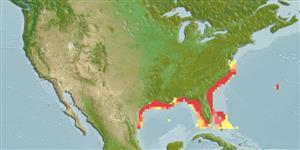Environment: milieu / climate zone / depth range / distribution range
Ekologi
marina bottenlevande; djupintervall 1 - 45 m. Subtropical; 38°N - 24°N, 98°W - 59°W
Western Atlantic: Virginia to southern Florida in USA and northern and eastern Gulf of Mexico.
Size / Vikt / Age
Maturity: Lm ? range ? - ? cm
Max length : 25.0 cm TL hane/ej könsbestämd; (Ref. 7251)
Inhabits shallow-water bays.
Life cycle and mating behavior
Könsmognad | Reproduktion | Lek | Ägg | Fecundity | Larver
Robins, C.R. and G.C. Ray, 1986. A field guide to Atlantic coast fishes of North America. Houghton Mifflin Company, Boston, U.S.A. 354 p. (Ref. 7251)
IUCN Red List Status (Ref. 130435: Version 2024-1)
Threat to humans
Harmless
Human uses
Verktyg
Special reports
Download XML
Internet-källor
Estimates based on models
Preferred temperature (Ref.
123201): 23 - 26.5, mean 24.1 °C (based on 170 cells).
Phylogenetic diversity index (Ref.
82804): PD
50 = 0.5000 [Uniqueness, from 0.5 = low to 2.0 = high].
Bayesian length-weight: a=0.00525 (0.00223 - 0.01237), b=3.13 (2.92 - 3.34), in cm total length, based on LWR estimates for this (Sub)family-body shape (Ref.
93245).
Trofisk nivå (Ref.
69278): 3.4 ±0.3 se; based on diet studies.
Resiliens (Ref.
120179): Mellan, lägsta populationsfördubblingstid 1,4-4,4 år (Preliminary K or Fecundity.).
Fishing Vulnerability (Ref.
59153): Low vulnerability (15 of 100).
Nutrients (Ref.
124155): Calcium = 151 [70, 329] mg/100g; Iron = 1.4 [0.7, 2.7] mg/100g; Protein = 16.5 [14.1, 19.4] %; Omega3 = 0.317 [0.141, 0.846] g/100g; Selenium = 23.3 [11.2, 62.7] μg/100g; VitaminA = 26.1 [8.4, 82.9] μg/100g; Zinc = 0.909 [0.612, 1.373] mg/100g (wet weight);
